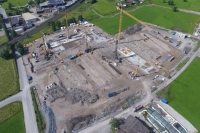Julius Blum GmbH, "Works 8", Dornbirn
Client: Julius BLUM GmbH, Höchst
Development Period: since April 2014
The Julius Blum GmbH with head office in Höchst (provincial state of Vorarlberg) is currently developing a new building complex in the area of Wallenmahd in Dornbirn, the "Works 8". This comprises a high-bay warehouse, several halls for various utilisation and an administrative building.
The external dimensions are 200 m x 140 m. The different parts of the building hold heights between 21 m and 36 m. Basements are not planned.
BGG is accompanying this project in the fields of geotechnics and hydrogeology from the very beginning. For this, subsoil explorations in form of core drillings and dynamic probings have been detemined, supervised and evaluated initially. Based on the results, an expert's statement was prepared for the building permission procedure. Furthermore, pile load tests have been planned and accompanied in order to establish geotechnical basic data.
During construction, a geological-geotechnical and a hydrogeological supervision is carried out.
Pile foundation:
In the project area, mostly cohesive, organic material with a very low bearing capacity and a high compressibility exists down to a depth of approximately 10 m. Below, a cohesive soil zone of clay with varying plasticity and a consistency of at maximum soft to stiff follows. In this layer, sand and gravel lenses are embedded locally. The base is formed by quaternary gravel, which sets in at a depth of 30 m. Because of this unfavourable underground situation, the design allowed for a deep foundation from the very beginning. With the purpose of minimising the foundation depth, the possibility of the foundation within the higher situated cohesive soil layer has been explored by three pile load tests. Finnally, piles with lengths of 29 m and diameters of 65 cm have been implemented.
By the chosen approach, an economically optimal foundation concept could be presented to the client. The savings due to the optimisation of the pile lengths were ten times higher than the costs of the pile tests.
May 2017
